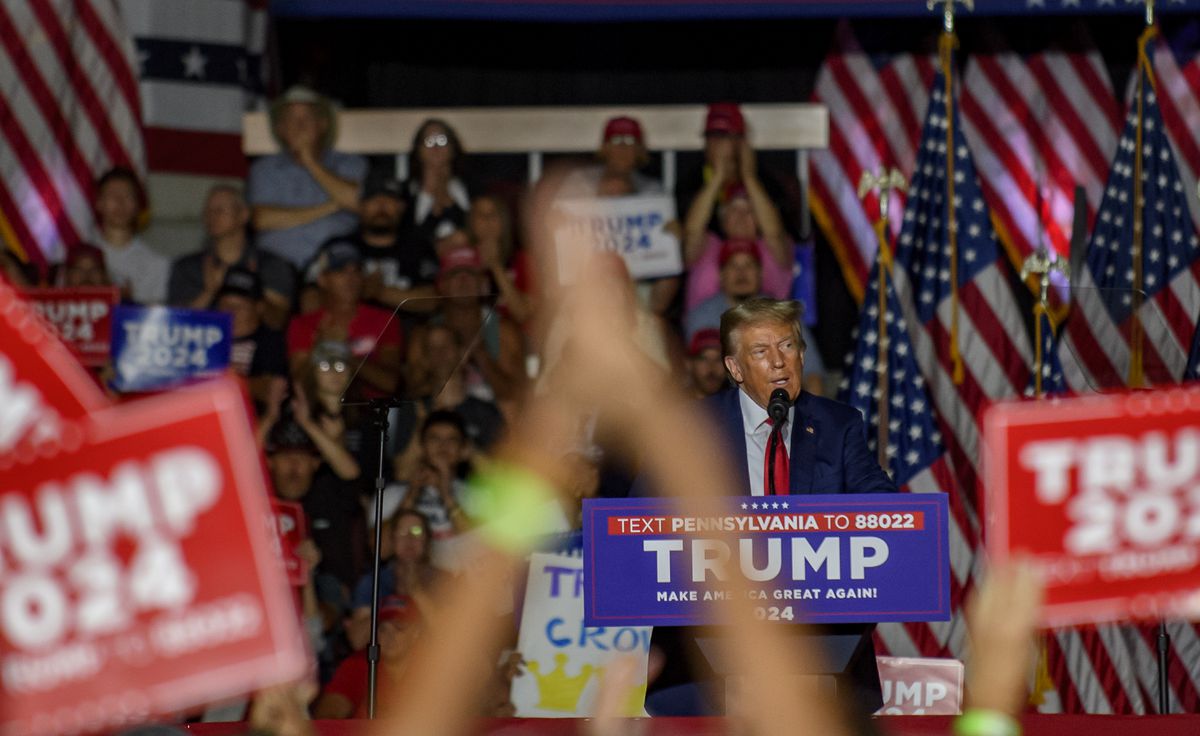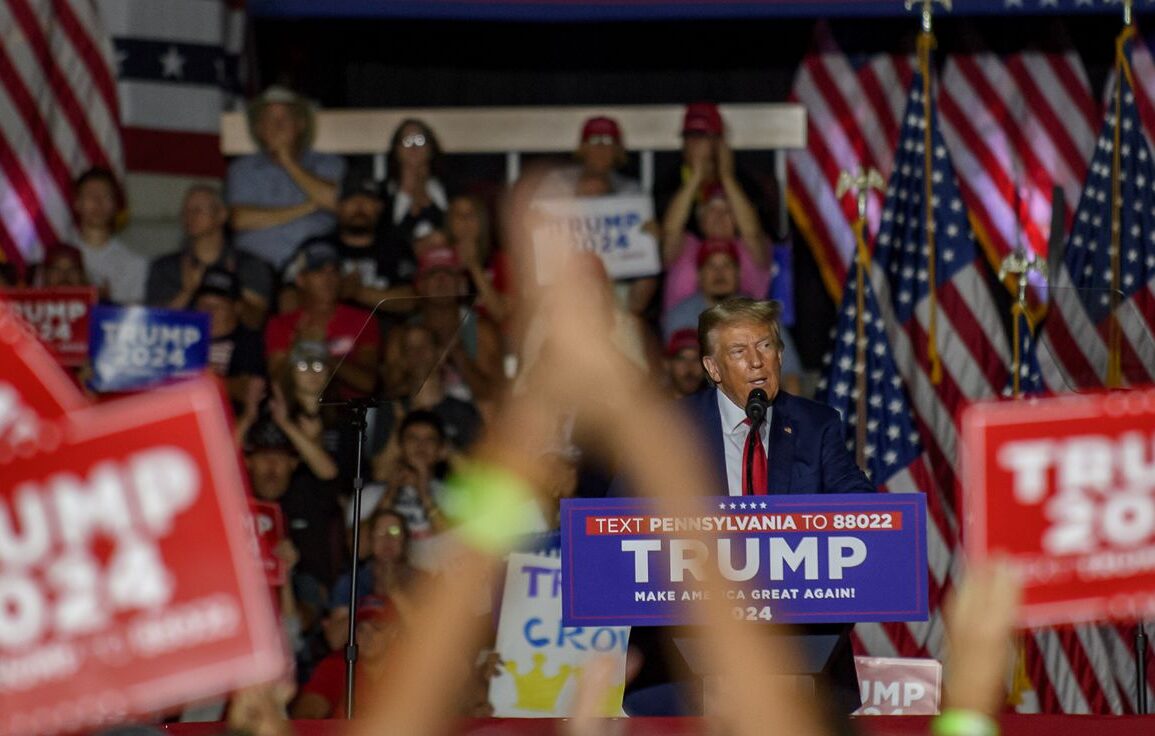The question of why Donald Trump manages to maintain such a grip on the Republican base, to the point where he can remain a nationally viable candidate despite all of his misdeeds and legal woes, is one of the most important issues in American politics. It’s a subject that has been explored extensively, with the best evidence converging on the same general story: Trump is the avatar of a kind of resentful reactionary politics, one uncomfortable with a changing America, that defines the worldview of a plurality (if not a majority) of the GOP faithful.
But this answer offers few easy solutions and makes some people uncomfortable, as it feels a bit too much like a judgment of Trump supporters. So we get efforts to reject the evidence, often relying on long-debunked alternative arguments.
The latest example of this phenomenon is David Brooks’s new column in the New York Times. In a piece titled “What if We’re the Bad Guys Here?”, Brooks criticizes those that would explain Trump’s persistent political support as a product of racism and anxious attachment to hierarchy. This explanation has some truth, he concedes, but is “also a monument to elite self-satisfaction.”
In its place, Brooks urges his readers “to try on a vantage point in which we anti-Trumpers are not the eternal good guys.” In this counterstory, Trump represents a boiling up of decades of working-class frustration with an economic system rigged in favor of those with college degrees. The elite’s unwillingness to face this hard truth, Brooks argues, is both a failure of introspection and a social disaster in the making.
“We can condemn the Trumpian populists all day until the cows come home, but the real question is when will we stop behaving in ways that make Trumpism inevitable,” Brooks writes.
Brooks’s column has been widely celebrated by American elites since its publication, reflecting the fact that — contrary to Brooks’s depiction — economic explanations for right-wing populism’s rise have long been the preferred theory of the elite. The guy who runs the annual global elite confab at Davos — Klaus Schwab, the head of the World Economic Forum — has embraced them. So have leading Democrats and many writers at America’s top journalistic outlets, including some of Brooks’s New York Times colleagues. J.D. Vance went from obscure venture capitalist to US senator entirely because he could sell a version of this narrative in his book Hillbilly Elegy (recently made into a Ron Howard movie starring Amy Adams and Glenn Close).
But the popularity of a narrative among the elite does not determine its truth or falsity; evidence does. And the data supporting this narrative is weak at best.
Rather, the best evidence typically points toward identity-based explanations: Racial and cultural conflicts are far, far more important than the kind of economic alienation Brooks wants to highlight. This is true not only in the United States but in other countries facing similar challenges from far-right populist movements — important comparison points that Brooks entirely leaves out.
Brooks’s column makes some important points, particularly about the flaws in the American economic model. But it’s one thing to point out those flaws, and another thing to posit that (as a matter of fact) they are behind the great divides in our politics — when in fact they are not.
And if we keep getting this wrong, we will never fully understand the nature of our democratic crisis — or what can be done to address it.
What Brooks gets wrong about Trump’s support and the economy
Since Trump’s surprise victory in 2016, people have been positing that “economic anxiety” drove his success, arguing that (for example) job loss from increased trade with China has been at the heart of Trump’s support. To Brooks’s credit, he puts a somewhat novel spin on these arguments, describing Trump’s support as a kind of class-based ideological resentment: a sense that the economy and society are rigged against people without college degrees.
“It’s easy to understand why people in less-educated classes would conclude that they are under economic, political, cultural and moral assault — and why they’ve rallied around Trump as their best warrior against the educated class,” he writes.
This is plausible in theory, but Brooks does nothing to support it. And when I say nothing, I mean literally nothing. His argumentative strategy is to note a series of ways in which the American socioeconomic model favors college-educated elites, and then assert that Trump support must be rooted in those factors without bothering to cite evidence that this is something Trump voters really care about.
This leads him to very odd places. Brooks asserts, for instance, that working-class voters have been alienated from the elite due to a divergence in child-rearing practices. “Members of our class still overwhelmingly married and then had children within wedlock. People without our resources, unsupported by social norms, were less able to do that,” he writes.
Yet unmarried parents have actually leaned Democratic for quite some time. A study of the 2016 election results published by the University of Virginia’s Institute for Family Studies finds that “Trump’s vote share decreased by 5.7 percentage points for every 10 percentage point increase in the share of single parents in a county.”
This illustrates a contradiction at the heart of the column. Brooks is trying both to critique America’s unequal political economy and explain why Trump’s support has proven durable. The problem is that things that are relevant to the first goal might not be relevant to the second one, and Brooks never bothers to distinguish between the two.
Even at times when Brooks does hit on economic structures that could plausibly matter, he does no work to show that they do.
Take the rural-urban divide, one of the most important features of American (and global) politics. Brooks suggests that the reason that Republicans are gaining in the hinterland is because it’s being left behind economically. “In 2020, Biden won only 500 or so counties, but together they are responsible for 71 percent of the American economy. Trump won over 2,500 counties, responsible for only 29 percent,” he writes.
A 2022 paper by two political scientists, Kristin Lunz Trujillo and Zack Crowley, examined this theory explicitly: testing a sense of political and cultural alienation (what they call “symbolic” concerns) versus a sense of economic deprivation in predicting rural voter support for Trump.
They found that “only the symbolic subdimensions of rural consciousness positively and significantly correlate with Trump support.” If anything, they found, rural voters who feel more economically deprived are less likely to vote for Trump than their peers.
Similarly, a 2020 paper found that Trump supporters in poorer areas tend to be the “locally affluent whites:” people whose incomes might not put them in the national one percent, but who are doing a fair sight better than others in the same zip code. Think plumbers and auto dealers, not laid-off factory workers.
The distribution of resources in modern America is indeed unfair, and poverty in rural America is something to take seriously — perhaps more seriously than some urban liberals do.
But the mere fact that an inequality exists, and is bad, does not mean it is What Caused Trump.
The overwhelming evidence for a cultural explanation
Let me propose an alternative theory — one that aligns much better with the available evidence than the economic anxiety idea.
This story starts with the late 20th-century revolution in social values: the end of segregation, mass nonwhite immigration, feminist challenges to patriarchy, a decline in traditional Christianity, and the rise of the LGBTQ movement. This revolution has transformed America at fundamental levels: the kinds of people who hold positions of power, the ideas that command cultural respect, and even the kinds of food Americans eat and languages they speak in public.
For millions of Americans, these changes made them feel unmoored from their country— “strangers in their own land,” as the sociologist Arlie Hochschild put it. Whether because of pure bigotry or a more diffuse sense of cultural alienation from the mainstream, a large number of Americans came to believe that they are losing America. For historical reasons owing largely to the legacy of the civil rights movement, these voters became concentrated in the Republican party — forming at least a plurality of its primary electorate. The election of Barack Obama, a self-described “Black man with a funny name,” pushed their sense of social alienation to the breaking point.
This cultural anxiety created room for Trump, who rode this group’s collective resentments to control of the Republican party. It is not the only reason he won the presidency — in a close election like 2016, a million different things likely made the difference — but it is the most important reason why he has maintained a lock on the Republican party for the better part of a decade.
We know this, primarily, because social scientists have been testing the theory since 2016 — and comparing it with Brooks’s preferred explanations rooted in resentment at a rigged economic game. Again and again, the cultural theory has won out.

For example, in 2018, a trio of scholars used survey data to compare explanations of Trump support based on racism, sexism, and a sense of economic alienation. The former two are far more powerful predictors than the latter, almost entirely explaining Trump’s surge in support among white non-college voters. “Controlling for racism and sexism effectively restores the education gap among whites to what it had been in every election since 2000,” they write.
A 2018 report from the Voter Study Group, authored by pollster Robert Griffin and political scientist John Sides, tested what they called the “prevailing narrative” of the 2016 election that “focused heavily on the economic concerns of [the white working class].” They found that typical methods of measuring economic distress were flawed and that more precise measurements show little effect on the 2016 outcome. “Instead,” they write, “attitudes about race and ethnicity were more strongly related to how people voted.”
A 2018 paper by Alan Abramowitz and Jennifer McCoy, two leading political scientists, tested correlations between white voters’ favorable views of Hillary Clinton and Trump and a battery of different variables. What they found, at this point, shouldn’t surprise you.
“After party identification, racial/ethnic resentment was by far the strongest predictor of relative ratings of Trump and Clinton — the higher the score on the racial/ethnic resentment scale, the more favorably white voters rated Trump relative to Clinton,” they write. “The impact of the racial/ethnic resentment scale was much stronger than that of any of the economic variables included in the analysis, including opinions about free trade deals and economic mobility.”
These are three studies from a single year. There are dozens of other papers, reports, and even entire books coming to similar conclusions. These studies don’t explain everything about Trump or Republican support — such as the party’s recent gains among Black and especially Latino voters — but they do an excellent job answering the question that Brooks poses in his column: Why does Trump maintain such a hard core of support despite everything that he’s done?
There’s also vital global context.
The United States is not the only country to be experiencing a rise in far-right populism. Countries that have very different economic trajectories — like Israel, Brazil, and India — have all seen the rise of Trump-style politics. That alone should raise questions about a narrative focusing on the specific economic problems of the United States, especially since those countries are wracked by significant cleavages surrounding ethnicity, race, religion, and gender.
Western European countries which have seen the rise of far-right parties are also a useful comparison. Like the US, those countries have experienced rising inequality — albeit to a lesser degree. But they’ve also experienced the same cultural convulsions in the second half of the 20th century alongside mass nonwhite migration that fundamentally challenged white Europeans’ sense of place and self.
And there’s a reason that immigration has been the number one most important issue for European far-right parties. Rigorous statistical studies of these peer countries, such as the conservative scholar Eric Kaufmann’s book Whiteshift, suggest cultural anxiety about Europe’s changing demographic makeup, rather than any fears about wage competition or economic inequality more broadly, is the key issue for those parties’ supporters.
“A comprehensive review of the academic literature on immigration attitudes in the West … found that personal income and economic circumstances explained little,” Kaufmann writes. “Cultural attitudes emerged as the most consistent predictor of anti-immigration attitudes. Survey experiments can prove causation rather than mere correlation.”
So, on the one hand, there is Brooks’s largely unevidenced theory — and, on the other, an absolute mountain of social scientific research.
Why Brooks’s column matters
I try to be fairly forgiving of newspaper columnists: Coming up with an actually interesting and original column idea multiple times a week is a lot harder than you think. But this Brooks column is important to talk about on its own, for at least two reasons.
First, Brooks’s column contributes to a false perception that non-college voters form a uniform bloc that moved entirely into the Republican corner. In reality, as the Washington Post’s Greg Sargent points out, a majority of Biden’s supporters did not have college degrees — owing primarily to his strength among nonwhite, non-college voters. The racial split among non-college voters has lessened but are still pronounced — a testament both to the diversity of the American working class and the primary salience of race in American politics.
Second, Brooks’s column is frustrating because it turns an important factual debate into a conversation about elite Americans’ feelings.
In his column, Brooks talks a lot about “narratives” and “stories” one could tell about Trump’s enduring popularity. What he wants, his stated objective, is to get his readers to feel differently about both Trump supporters and themselves.
“Let me try another story on you. I ask you to try on a vantage point in which we anti-Trumpers are not the eternal good guys. In fact, we’re the bad guys,” Brooks writes.
But this isn’t literary analysis. We’re talking about questions of fact: Competing social scientific theories about why a particular phenomenon, Trump’s persistent and enduring hard core of political support, exists out in reality. The question is not how David Brooks and his friends feel about Trump’s base, but whether what they believe about them is true.
To figure out how to get the country past its current impasse, we need to look at reality as it is, not as we imagine it might be. And the reality is that our deep political divide is rooted, first and foremost, in profound and largely irreconcilable views of who America is for and what its social hierarchy should look like. That may be unpleasant for Brooks — and all of us — to contemplate, but reality’s ugliness doesn’t provide an excuse for ignoring it.








